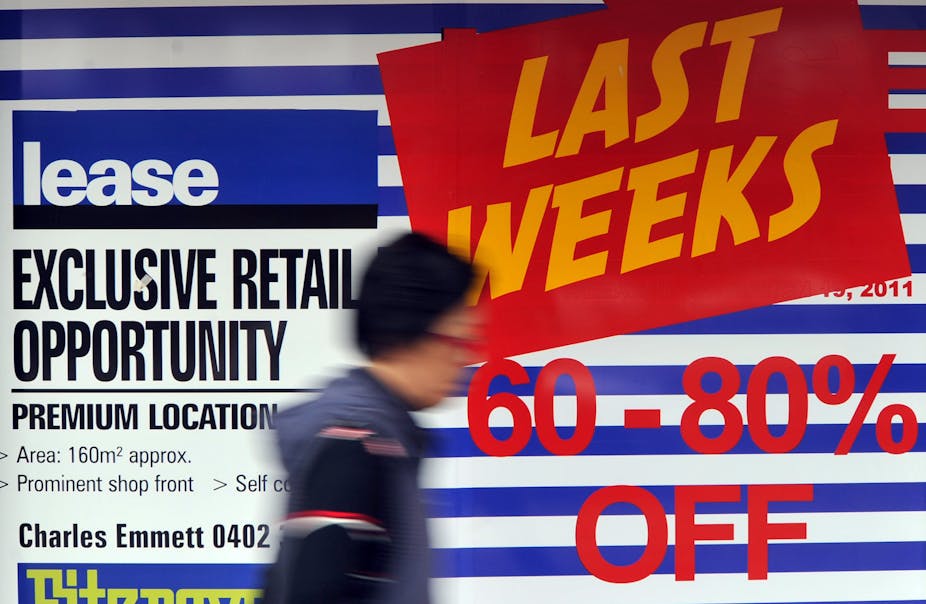The news that clothing and footwear chain Colorado is to close its doors will no doubt be greeted as further proof of bricks-and-mortar retail’s imminent extinction.
Coupled with Small Business Minister Nick Sherry’s suggestion yesterday that Australian bookshops will “cease to exist” within five years, Colorado’s demise will add currency to the view that retailers face a bleak future as consumers migrate online.
But should Australian retailers despair? Experience shows that the retail sector has successfully adapted to consumer trends before.
Shopping around
For the vast majority of retailing history, the physical, bricks-and-mortar environment has provided both the focus and the context for customer engagement.
Established brands in all major consumer economies grew store chains and networks and competed on the traditional marketing pillars of price, product, place and promotion.
As part of this market evolution, independent retailers lost ground to both the shopping centre and the national (and international) chain, as consumers sought the convenience of location and the confidence of the big brand.
Since the explosion of internet and multi-channel retailing in the last decade, the paradigm has shifted again.
Online sales have grown rapidly in recent years, to take a significant and increasing share of the retail dollar.
Market analysts Forrester Research conservatively predicted that online trade will make up 8% of total retail sales in the US and Europe by 2014, although many analysts anticipate that both growth and market share will far exceed these expectations.
With technology at their disposal, consumers are using movements in international currency markets to take advantage of lower overseas product costs, a move which has revealed many domestic retailers to be – on face value at least – overpriced and uncompetitive in key categories like home electronics, books and music.
Social media has also changed the way that consumers research, learn and shop on the move.
In Australia, mobile internet penetration has now reached 50%, with customers often seeking the opinion of other consumers on their purchases. In the process, they’re bypassing the mainsteam marketing messages of retailers.
Buying into change
The multi-channel consumer is here to stay, and many retailers are scrambling to get up to speed with their technology-loving customers, launching mobile phone apps and facebook pages and evolving the role that the internet plays in both promotions and transactions.
However, the reality is that the majority of retailers are anchored to significant store networks and the vast majority of consumers still spend significant “store-time” shopping.
Although the significance of the internet and social media is not to underestimated, the very conservative recent sales trends noted in Australia reveals that retailers need more than ever to optimise every customer contact and engagement opportunity to drive customer numbers, average invoice value and customer satisfaction.
The dawn of the virtual retail age is fundamentally changing the DNA of the industry.
As new measurements of performance enter our vocabulary, it is important for retailers not to overlook new thinking in relation to their physical store environments.
Sensory advantage
At it’s core, a visit to a retail store is and always has been a sensory experience: sight, sound, touch, feel, taste all shape the propensity to purchase, with the subsequent opinions, emotions and experiences generated forming shaping the purchase process.
Our newest sense, “e-sense”, also plays a part as consumers move between physical and virtual aspects of retail engagement, often in real time.
Optimising consumers’ sensory and emotional experiences in store is vital to the future success of bricks and mortar retail.
As it becomes increasingly difficult for store-based businesses to compete on price, range, convenience, time saving and transactional efficiency, it’s imperative to evolve a new points of competitive advantage and physical store trading philosophies.
They must capitailse upon the estimated 100 billion neurons in the human brain across the consumers five (and potentially six) key senses in a way that pure online retailing never can.
However, many retailers do not capitalise upon the full potential that their physical retail spaces offer in terms of sensory and emotional engagement – despite the fact that academic and industry research continues to reveal significant potential for advancement in, for example, ambience, marketing messaging, engagement and service interaction, multi-channel involvement and promotional optimisation.
Rather than preparing for the apocalypse, retailers must take a fresh look at all aspects of store engagement and breath new life into the shopping experience.

